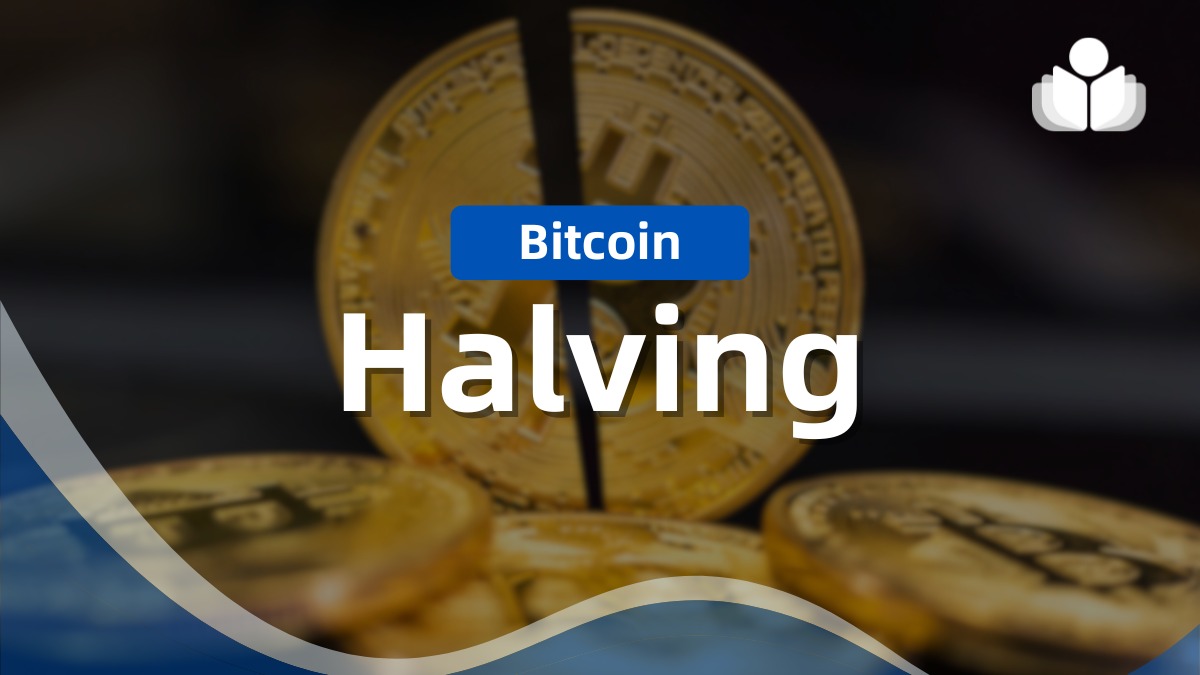The world’s first cryptocurrency has become a significant player in the global financial landscape. Central to its protocol is an event known as Bitcoin Halving.
This process occurs approximately every four years, is a fundamental part of Bitcoin’s design, and significantly influences its supply and market behavior. In this article, we’ll explore Bitcoin Halving in detail, examining its mechanics, historical impact, and implications for the future.
What is Bitcoin Halving?
Bitcoin Halving, also called “halvening,” is the process by which the reward for mining new blocks is halved, reducing the rate at which new bitcoins are created. This event occurs every 210,000 blocks, roughly every four years, and is hardcoded into the Bitcoin protocol by its pseudonymous creator, Satoshi Nakamoto.
What Happens When Bitcoin Is Halving?
Bitcoin halving is a critical event in the Bitcoin network. During this event, the reward for mining new blocks is halved, reducing the rate at which new bitcoins are created. This mechanism is embedded in Bitcoin’s protocol to control its supply and mimic the scarcity of precious metals like gold.
Halving has significant implications for miners, investors, and the broader market. For miners, reduced rewards can impact profitability, potentially leading to a consolidation of mining operations. For investors, halving often generates increased interest and speculation, historically correlating with price increases due to the reduced supply of new coins.
Overall, Bitcoin’s halving serves as a reminder of the cryptocurrency’s deflationary nature and its long-term value proposition as a scarce digital asset.
The Mechanics of Halving
Bitcoin operates on a blockchain, a decentralized ledger that records all transactions. Miners validate transactions and add them to the blockchain by solving complex mathematical problems, a process known as proof-of-work.
Miners are rewarded with newly created bitcoins for their efforts. Initially, the reward for mining a block was 50 bitcoins. The first halving occurred in 2012, reducing the reward to 25 bitcoins. Subsequent halvings in 2016 and 2020 reduced the rewards to 12.5 and 6.25 bitcoins, respectively.
The next halving will occur in 2024, reducing the reward to 3.125 bitcoins per block. This reduction in supply is designed to continue until the total supply of Bitcoin reaches its cap of 21 million, projected to occur around 2140.
Historical Impact of Bitcoin Halving
Bitcoin Halving events have historically had significant effects on the cryptocurrency market, particularly on the price of bitcoin.
The First Halving (2012)
The first halving occurred on November 28, 2012, reducing the block reward from 50 to 25 bitcoins. Before the halving, the price of Bitcoin hovered around $12.
Within a year, the price surged to over $1,000, marking a significant increase. This dramatic rise in price can be attributed to the reduced supply of new bitcoins entering the market, combined with growing demand.
The Second Halving (2016)
The second halving occurred on July 9, 2016, reducing the reward to 12.5 bitcoins. Leading up to the halving, the price of Bitcoin saw steady growth, reaching around $650.
Following the halving, the price experienced another substantial increase, peaking at nearly $20,000 in December 2017. This period also saw a surge in media attention and mainstream adoption, further driving demand.
The Third Halving (2020)
The most recent halving occurred on May 11, 2020, cutting the block reward to 6.25 bitcoins. Before the event, bitcoin’s price was approximately $8,500.
In the months following the halving, the price experienced a significant bull run, reaching an all-time high of over $64,000 in April 2021. This rise was fueled by increased institutional investment, growing recognition of Bitcoin as a hedge against inflation, and continued mainstream adoption.
Is Investing in Bitcoin During a Halving a Good Idea?
Many in the crypto community are excited about the prospect of investing in Bitcoin during a halving event. If you’re considering entering this market, here are some things you should know.
A Bitcoin halving happens roughly every four years. During this event, the reward for mining new Bitcoin transactions is cut in half. This means miners receive 50% fewer bitcoins for verifying transactions. This process reduces the supply of new bitcoins entering the market, historically leading to an increase in Bitcoin’s price.
Why does this matter? Simple supply-and-demand economics. When supply drops, and demand remains constant or rises, prices generally go up. This has been the pattern with previous Bitcoin halvings, with significant price increases following each event.
For example, after the 2016 halving, Bitcoin’s price rose from around $650 to nearly $20,000 in December 2017. However, investing in Bitcoin isn’t without risks.
The market is known for its volatility, with prices capable of swinging dramatically in short periods. While historical trends might suggest price increases following a halving, there’s no guarantee this pattern will continue.
Additionally, regulatory changes, market sentiment, and technological developments can all impact Bitcoin’s price. If you’re considering investing during a halving, it’s essential to research thoroughly and understand the risks involved. Diversifying your investments and not putting all your funds into Bitcoin is a wise approach to mitigate potential losses.
In conclusion, while Bitcoin halvings have historically been associated with price increases, investing during these times requires careful consideration and a solid understanding of the market dynamics. Make informed decisions and be prepared for the inherent risks of cryptocurrency investing.
Factors Influencing Bitcoin Price Post-Halving
While halvings have historically been associated with price increases, several factors contribute to this trend.
Supply and Demand Dynamics
The fundamental economic principle of supply and demand plays a crucial role in Bitcoin’s price movements. Halving events reduce the rate at which new bitcoins are introduced into circulation, effectively lowering supply.
If demand remains constant or increases, the reduced supply can lead to higher prices. This scarcity effect is a primary driver behind the post-halving price surges observed in previous cycles.
Market Sentiment and Speculation
Market sentiment and speculation also significantly impact Bitcoin’s price. Leading up to halvings, anticipation, and positive sentiment often drive demand.
Investors and traders speculate that the reduced supply will result in higher prices, leading to increased buying activity. This speculative behavior can create a self-fulfilling prophecy, as rising prices attract more investors, further driving up demand.
Institutional Investment
The growing involvement of institutional investors has been a notable trend in recent years. Large financial institutions, hedge funds, and publicly traded companies have increasingly recognized Bitcoin as a legitimate asset class.
Institutional investment can provide substantial liquidity and stability to the market, contributing to price appreciation. Notably, the 2020-2021 bull run saw significant participation from institutional players, including companies like MicroStrategy and Tesla, which added bitcoin to their balance sheets.
Macroeconomic Factors
Macroeconomic factors, such as monetary policy, inflation, and global economic conditions, also influence bitcoin’s price post-halving. Bitcoin is often viewed as a hedge against inflation and currency devaluation.
In times of economic uncertainty or when central banks implement expansionary monetary policies, investors may turn to Bitcoin as a store of value. The COVID-19 pandemic and subsequent economic stimulus measures in 2020-2021 highlighted this trend, contributing to bitcoin’s price surge following the third halving.
Long-Term Implications of Bitcoin Halving
Bitcoin Halving events have long-term implications for the cryptocurrency ecosystem, affecting miners, investors, and the broader market.
Mining Economics and Network Security
Halving events impact the economics of mining, reducing the rewards miners receive for validating transactions. As block rewards decrease, miners rely more on transaction fees to sustain their operations.
If Bitcoin’s price doesn’t increase sufficiently to offset the reduced rewards, some miners may become unprofitable, potentially reducing network security. However, Bitcoin’s design includes mechanisms to adjust mining difficulty, ensuring that block production continues stable.
Scarcity and Store of Value
Bitcoin’s fixed supply and predictable issuance schedule contribute to its perception as a store of value. With each halving, the rate of new bitcoin creation decreases, reinforcing its scarcity. This scarcity is akin to precious metals like gold, which have limited supplies.
As a result, bitcoin is often referred to as “digital gold,” with proponents arguing that its scarcity and decentralized nature make it a superior store of value compared to traditional fiat currencies.
Market Maturity and Adoption
As bitcoin matures, each halving event serves as a milestone in its development. The growing awareness and understanding of Bitcoin among investors, regulators, and the general public contribute to its mainstream adoption.
Increased adoption can lead to greater liquidity, reduced volatility, and a more robust market infrastructure. The maturation of the bitcoin market also paves the way for the development of financial products, such as bitcoin Exchange-Traded Funds (ETFs), which can further drive institutional participation and adoption.
Challenges and Risks
While Bitcoin Halving events have historically been associated with positive outcomes, they also present challenges and risks.
Price Volatility
Bitcoin is known for its price volatility, and halvings can exacerbate this characteristic. The anticipation and speculative behavior surrounding halvings can lead to significant price swings, creating opportunities for gains and losses. Investors must be prepared for heightened volatility and exercise caution when participating in the market.
Regulatory Uncertainty
Regulatory developments can impact the bitcoin market, and halving events may attract increased regulatory scrutiny. Governments and regulatory bodies worldwide are still grappling with classifying and regulating cryptocurrencies.
Changes in regulatory frameworks can influence market dynamics, affecting investor sentiment and market participation. Regulatory clarity and favorable policies can promote adoption, while restrictive measures may hinder growth.
Technological and Security Risks
The security and reliability of the Bitcoin network are paramount. Halving events, particularly if they reduce mining participation, can test the network’s resilience.
Additionally, technological advancements and potential vulnerabilities pose ongoing risks. Ensuring the continued security and stability of the network requires ongoing innovation and collaboration within the Bitcoin community.
Future Outlook
The future of Bitcoin Halving and its impact on the market remains a topic of speculation and debate. While historical trends provide valuable insights, the evolving nature of the cryptocurrency ecosystem introduces new variables and uncertainties.
Increased Institutional Adoption
The trend of increased institutional adoption will likely continue, with more companies and financial institutions recognizing Bitcoin’s potential as an asset class. Institutional participation can provide stability and legitimacy to the market, attracting more investors and driving demand.
Development of Layer 2 Solutions
As block rewards decrease, transaction fees become a more significant source of revenue for miners. This shift may incentivize the development and adoption of layer 2 solutions, such as the Lightning Network, which aim to improve transaction scalability and reduce fees. Layer 2 solutions can enhance the usability and efficiency of the Bitcoin network, supporting its long-term growth.
Integration with Traditional Finance
Another key area of development is the integration of Bitcoin with traditional financial systems. As regulatory frameworks evolve and financial institutions embrace cryptocurrencies, the potential for Bitcoin to be used as a medium of exchange and store value in everyday transactions increases.
Payment processors, FinTech companies, and central banks exploring digital currencies may drive further integration and adoption.
Conclusion – Bitcoin Halving
Bitcoin Halving is a fundamental aspect of the cryptocurrency’s design, with significant implications for its supply, market behavior, and long-term value proposition. While halvings have historically been associated with price increases, they also introduce challenges and risks that must be carefully considered.
As the cryptocurrency ecosystem continues to evolve, the impact of future halving events will depend on a complex interplay of factors, including market dynamics, regulatory developments, and technological advancements.
Understanding the mechanics and historical context of Bitcoin Halving is crucial for investors to make informed decisions. While past performance doesn’t indicate future results, the principles of supply and demand, market sentiment, and macroeconomic factors provide valuable insights into the potential outcomes of future halvings.
As Bitcoin matures and gains broader acceptance, its role in the global financial system will continue to evolve, shaping the future of digital assets and decentralized finance.
 Sections of this topic
Sections of this topic
















